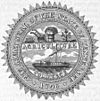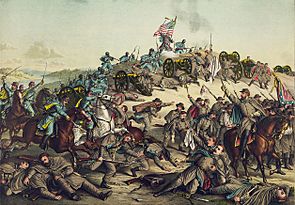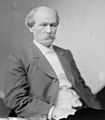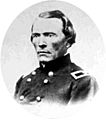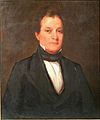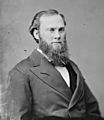Tennessee in the American Civil War facts for kids
Quick facts for kids Tennessee |
|||||
|---|---|---|---|---|---|
| Nickname(s): The Volunteer State | |||||
|
|||||
| Capital | Nashville | ||||
| Largest City | Memphis | ||||
| Admission to confederacy | July 2, 1861 (11th) | ||||
| Population |
|
||||
| Forces supplied |
|
||||
| Governor | Isham G. Harris (1861–1862) | ||||
| Senators | Landon Carter Haynes Gustavus Adolphus Henry |
||||
| Representatives | List | ||||
| Restored to the Union | July 24, 1866 | ||||
The American Civil War greatly impacted Tennessee, with battles happening in every single county. During the war, Tennessee was a Confederate state. It was the last state to officially leave the Union and join the Confederacy. Tennessee had considered leaving the Union even before the Confederacy was formed. However, it only officially seceded after the Battle of Fort Sumter. This event caused a huge shift in public opinion across the state. Tennessee left the Union to protest President Lincoln's call for 75,000 state militia members. These troops were meant to stop the rebellion. Even though Tennessee provided many soldiers for the Confederacy, it also sent more soldiers to the Union Army than any other Confederate state.
In February 1862, some of the war's first major battles happened along the Tennessee and Cumberland rivers. These rivers were important routes for military movement. Mountain passes like Cumberland Gap were also fiercely fought over by both sides. The Battle of Shiloh and fighting along the Mississippi River brought fame to Ulysses S. Grant. His commander, Henry Halleck, was promoted to General-in-Chief. The Tullahoma campaign, led by William Rosecrans, pushed the Confederates out of Middle Tennessee very quickly. They didn't lose many soldiers and were strong enough to defeat Rosecrans later. At Nashville in December 1864, George Thomas defeated the Army of Tennessee led by John Bell Hood. This was the last major battle fought in Tennessee.
In 1862, President Lincoln used his power as commander in chief to make Andrew Johnson the military governor of Tennessee. Two years later, Lincoln chose Johnson, a Southerner, to be his running mate in the 1864 election. After Lincoln's assassination, Johnson became president.
Contents
Tennessee's Path to War
Early Feelings About Leaving the Union
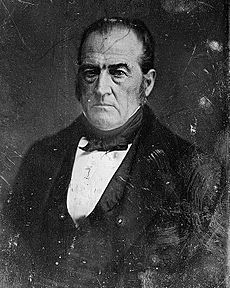
At first, most people in Tennessee were not eager to break away from the United States. In 1860, they had voted for John Bell. He was from Tennessee and a moderate who wanted to find a peaceful solution to the crisis.
However, some Tennesseans strongly criticized the Northern states and President Lincoln. Newspapers like the Nashville Daily Gazette said that Southern states were preparing to resist any force or invasion. They believed states like Florida and Georgia were right to take control of military forts within their borders.
Governor Isham G. Harris called a special meeting of the Tennessee General Assembly in January 1861. He said the Southern states were leaving because of "long continued agitation of the slavery question." He also worried about the growing Republican Party. He claimed this party was against the rights of Southern citizens, especially regarding slavery. Governor Harris suggested holding a special meeting for the state to decide its future.
The issue of slavery was central to why states wanted to leave the Union. Newspapers at the time openly discussed this. Some pro-slavery papers even warned voters that if they didn't act, they would be "sold out" to "Yankee Republicans." They argued that white people were "superiors of the black man."
In February 1861, a pro-Union newspaper in Knoxville revealed a secret plan. This plan was by pro-slavery Tennesseans to spread propaganda. They wanted to make it seem like most people supported leaving the Union. The plan urged supporters to work hard to convince others before Lincoln became president. It also said that Tennessee should join its "Southern brethren" rather than be "chained to the car of Black Republican States."
On February 9, 1861, Tennessee voted on whether to send delegates to a meeting that would decide on secession. Most people voted against it. About 54 percent of voters said no to the idea. This meant that if a meeting had been held, most delegates would have been against leaving the Union. This result disappointed those who wanted to leave.
How Fort Sumter Changed Minds
When Fort Sumter was attacked on April 12, 1861, everything changed. President Lincoln then asked for 75,000 volunteers to bring the seceded states back into the Union. This made public opinion in Tennessee turn sharply against the Union.
Many Union supporters, even those who later joined the Confederacy, felt Lincoln's call for troops was a disaster. They believed it meant the North planned to invade and conquer the Southern states. This made many people who had been loyal to the Union become very angry and passionate. They felt they had to "fight for our hearthstones and the security of home."
In May 1861, Governor Isham G. Harris started preparing Tennessee for war. He sent a proposal to the state's assembly to leave the Union. He also talked directly with the Confederate government. All this happened before Tennessee officially seceded.
Tennessee Leaves the Union
On June 8, 1861, Tennessee held another vote. East Tennessee strongly voted against leaving the Union. However, West Tennessee voted heavily in favor. The deciding votes came from Middle Tennessee. In February, 51 percent of people there were against secession. But in June, 88 percent voted in favor. Some people claimed there was cheating in the voting. In some East Tennessee counties, Union supporters threatened those who voted for secession. In other places, soldiers stood at the polls to boo Union voters.
After this vote, Tennessee officially joined the new Confederacy. It was the last state to formally announce it was leaving the Union.
Major Battles and Campaigns
1862: Rivers and Key Cities
Controlling the Cumberland and Tennessee Rivers was very important. These rivers were like highways for steamboats. In February 1862, Ulysses S. Grant and the United States Navy took control of these rivers. They then stopped a Confederate attack at the Battle of Shiloh in April.
The Union captured Memphis and Nashville. This gave them control of the western and middle parts of Tennessee. This control was confirmed at the Battle of Murfreesboro in early 1863. After Nashville fell, Andrew Johnson, who was from East Tennessee, became the military governor. During this time, the military government tried to end slavery. Even with strong Union support in East Tennessee, the Confederates held onto it for a while.
1863: Turning the Tide
After winning the Battle of Chickamauga in September 1863, the Confederates surrounded Chattanooga. But Grant's forces drove them away in November. Many Confederate losses were due to poor leadership from General Braxton Bragg. He led the Army of Tennessee from Shiloh until the defeat in the Chattanooga campaign. Historians say Bragg was good at planning but often failed in battles. This was partly because he couldn't work well with his officers.
1864: The Final Battles
The last major battles in Tennessee happened when General John Bell Hood led the Confederates north in November 1864. His army was stopped at Franklin. Then, George Thomas's much larger forces almost completely destroyed Hood's army at Nashville in December.
Battles in Tennessee
- Anthony's Hill
- Bean's Station
- Blountville
- Blue Springs
- Brentwood
- Britton's Lane
- Brown's Ferry
- Bull's Gap
- Campbell's Station
- First Battle of Chattanooga
- Second Battle of Chattanooga
- Third Battle of Chattanooga
- Collierville
- Columbia
- Dandridge
- Dover
- Fair Garden
- Farmington
- Fort Donelson
- Fort Henry
- Fort Pillow
- Fort Sanders
- First Battle of Franklin
- Second Battle of Franklin
- Hartsville
- Hatchie's Bridge
- Hoover's Gap
- Island Number Ten
- Jackson
- Johnsonville
- Lebanon
- Lexington
- Liberty Gap
- First Battle of Memphis
- Second Battle of Memphis
- Morristown
- Mossy Creek
- First Battle of Murfreesboro
- Third Battle of Murfreesboro
- Nashville
- Parker's Cross Roads
- Plum Point Bend
- Riggins Hill
- Battle of Rogersville
- Shiloh
- Spring Hill
- Stones River
- Thompson's Station
- Vaught's Hill
- Wauhatchie
Leaders from Tennessee
Notable Confederate Leaders
-
C.S. Postmaster Gen.
John Henninger Reagan -
Lt. Gen.
Nathan Bedford Forrest -
Lt. Gen.
Leonidas Polk -
Lt. Gen.
Alexander P. Stewart -
Sen.
Henry S. Foote -
Gov.
Isham G. Harris -
TN House of Rep. & Brig. Gen.
Robert H. Hatton -
Brigadier General
William H. Carroll -
Brigadier General
George Maney -
Brigadier General
Charles M. Shelley -
Brigadier General
William Read Scurry -
Brigadier General
Robert V. Richardson -
Brigadier General
Benjamin McCulloch -
Lt. Colonel
John DeWitt Clinton Atkins
Notable Union Leaders
-
President
Andrew Johnson -
Bvt. Maj. Gen.
William S. Harney -
Rear Adm. & Brig. Gen.
Samuel P. Carter -
Brigadier General
James G. Spears -
Brigadier General
William B. Campbell -
Brigadier General
Alvan C. Gillem -
Bvt. Brig. Gen.
William Jay Smith -
U.S. House of Rep. & Lt. Col.
Isaac R. Hawkins -
Rear Admiral
David G. Farragut -
War Governor
William G. Brownlow -
Surgeon & U.S. House of Rep.
Andrew Jackson Clements -
Brig. Gen. & Bvt. Maj. Gen.
Joseph Alexander Cooper -
Lieutenant
George Lewis Gillespie Jr.
Government and Politics During the War
People across Tennessee worried about disloyalty. In West and Middle Tennessee, there was fear of pro-Union activities. Local "Committees of Safety and Vigilance" worked to stop Union supporters. These groups spied, checked mail, and sometimes forced men to join the Confederate Army. They also took private property. The Union Army stopped these committees when it took control in 1862.
East Tennessee and Union Support
| Area of Tennessee | Percentage of Slaves |
|---|---|
| East Tennessee | 9% |
| Middle Tennessee | 29% |
| West Tennessee | 34% |
East Tennessee was a strong supporter of the Union. Most enslaved people there worked as house servants, not on large plantations. East Tennesseans worried they would become second-class citizens in a state with a powerful slave-owning upper class. They strongly opposed leaving the Union.
Representatives from twenty-six East Tennessee counties met and decided to try to leave Tennessee. They asked the state legislature in Nashville, but their request was denied. Confederate troops were sent to occupy East Tennessee and prevent it from leaving.
So, the region was under Confederate control from 1861 to 1863. However, many East Tennesseans joined the Federal army. They also fought against state authorities by burning bridges, cutting telegraph wires, and spying for the North. East Tennessee became an early base for the Republican Party in the South. Union forces finally captured the region in 1863.
Tennessee's Economy During the War
Many people moved to Nashville during the war. There were plenty of jobs in supply depots, warehouses, and hospitals supporting the war effort. Also, Nashville was safer than the countryside. Union supporters, Confederate sympathizers, free Black people, and escaped slaves all moved there. Business people from the North also came.
The South didn't have much heavy industry. But the Western Iron District in Middle Tennessee was the Confederacy's largest iron producer in 1861. The Confederate War Department tried to protect large operations like the Cumberland Iron Works, but they failed.
After the War
In January 1865, a meeting was held to propose changes to Tennessee's constitution. This meeting, led by pro-Union forces and Military Governor Andrew Johnson, suggested two important changes. One change would abolish slavery and forced labor, except as punishment for a crime. The other would reject Tennessee's connection with the Confederate States of America. Voters approved both changes on February 22, 1865.
(A new proposed change to the constitution will be voted on in 2022. It aims to completely remove slavery as a punishment for crime from the state constitution.)
After the war, Tennessee was the first state to be readmitted to the Union on July 24, 1866. This was because it approved the Fourteenth Amendment to the United States Constitution on July 18, 1866. Because of this, Tennessee was the only state that left the Union that did not have a military governor during Reconstruction.
However, many white Tennesseans were unhappy with the Confederate defeat. They resisted efforts to give voting rights and other civil rights to formerly enslaved people. For generations, white Tennesseans had been taught that slavery was right. Some could not accept that their former slaves were now equal under the law. When the state Supreme Court said that African Americans could vote in 1867, the resistance grew stronger.
The Nashville Republican Banner newspaper wrote in January 1868 that white Southerners should start a movement. They wanted to end the Republican Party's control and bring back laws that made Black people unequal.
The newspaper urged its readers to focus on a "local movement" to end Republican rule.
In 1860, African Americans made up only 25% of Tennessee's population. This meant they couldn't control politics. Only a few African Americans served in the Tennessee legislature during Reconstruction. However, their increased presence on the Nashville city council, where they held about one-third of the seats, worried some. Tennessee has strong memories of the Confederacy. These memories often focus on the Lost Cause idea, which sees the war as a heroic defense of traditional freedoms.
See also
- List of Tennessee Confederate Civil War units
- List of Tennessee Union Civil War units
- Nashville in the Civil War
- Chattanooga in the American Civil War
- History of slavery in Tennessee
- 1861 Tennessee gubernatorial election



